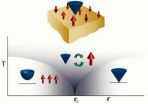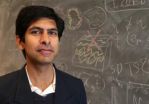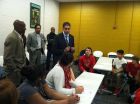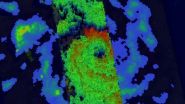(Press-News.org) UC Santa Barbara physicist Tarun Grover has provided definitive mathematical evidence for supersymmetry in a condensed matter system. Sought after in the realm of subatomic particles by physicists for several decades, supersymmetry describes a unique relationship between particles.
"As yet, no one has found supersymmetry in our universe, including at the Large Hadron Collider (LHC)," said the associate specialist at UCSB's Kavli Institute for Theoretical Physics (KITP). He is referring to the underground laboratory in Switzerland where the famous Higgs boson was identified in 2012. "This is a fresh insight as to how supersymmetry arises in nature." The findings of Grover's research, conducted with colleagues Donna Sheng and Ashvin Vishwanath, appear in the current online edition of the journal Science.
The fundamental constituents of matter — electrons, quarks and their relatives — are fermions. The particles associated with fundamental forces are called bosons. Several decades ago, physicists hypothesized that every type of particle in the Standard Model of particle physics, a theory that captures the dynamics of known subatomic particles, has one or more superpartners — other types of particles that share many of the same properties but differ in a crucial way.
If a particle is a fermion, its superpartner is a boson, and if a particle is a boson, its superpartner is a fermion. This is supersymmetry, a postulated unique theoretical symmetry of space.
While the Standard Model governing the ordinary world is not supersymmetric, it is often theorized that the more "fundamental" theory relevant to very hot systems, such as those probed in high-energy particle accelerators like the LHC (or higher energy ones yet to be built), might exhibit supersymmetry. This has yet to be proved or disproved by accelerator experiments.
However, through their calculations, Grover and his co-authors show that supersymmetry emerges naturally in a topological superconductor. An example is helium-3, a light, nonradioactive isotope of helium with two protons and one neutron (common helium has two neutrons). When helium-3 is cooled to almost absolute zero (0 Kelvin), it becomes a liquid superconductor. As understood only recently, the boundary of its container features fermions.
"The reason these fermions exist is related to time-reversal symmetry, which is unrelated to supersymmetry," said Grover. A video of an object tossed vertically up in the air is a good example of time-reversal symmetry. When the video is played back, it shows the object following the same parabolic trajectory through the air as it did when the video was played normally. "We wanted to see what would happen to these fermions when time-reversal symmetry was broken," Grover explained.
The scientists theorized that the application of a specified amount of magnetic field to the surface of the container would break the time-reversal symmetry. This, in turn, would cause the fermions to disappear due to their interaction with bosons that already exist in the liquid helium-3. Grover and his coauthors found that right at the point when fermions are about to disappear, the fermions and the bosons behave as superpartners of each other, thus providing a condensed matter analog of supersymmetry.
According to physicists, if supersymmetry can be proved in high-energy experiments, it opens the door to answers that physicists have been seeking for years and may pave the way to analyze and even integrate different fundamental physics theories such as quantum field theory, string theory and Einstein's relativity.
"Grover's team shows that supersymmetry may be studied in low-energy experiments," said physics professor Leon Balents, Grover's colleague at KITP. "This would be amazing in its own right and could serve as an inexpensive tabletop model for what to look for at particle accelerators."
"Our paper provides insight into how and in what systems supersymmetry may emerge in a very natural way," Grover said. "Maybe it doesn't exist in our actual universe, but there exist these condensed matter systems, such as topological superconductors, where supersymmetry can exist. This opens the window for experimentalists to go and test supersymmetry and its exciting consequences in real life."
INFORMATION:
One kind of supersymmetry shown to emerge naturally
A UCSB physicist outlines how this unique phenomenon occurs in a condensed matter system
2014-04-09
ELSE PRESS RELEASES FROM THIS DATE:
Violence intervention program effective in Vanderbilt pilot study
2014-04-09
Violent behavior and beliefs among middle school students can be reduced through the implementation of a targeted violence intervention program, according to a Vanderbilt study released in the Journal of Injury and Violence Research.
Manny Sethi, M.D., assistant professor of Orthopaedic Surgery and Rehabilitation, and his Vanderbilt co-authors evaluated 27 programs nationwide as part of a search for an appropriate school-based violence prevention program.
Their findings led to a single, evidence-based conflict resolution program that was evaluated in a pilot study of ...
Stanford scientists discover a novel way to make ethanol without corn or other plants
2014-04-09
Stanford University scientists have found a new, highly efficient way to produce liquid ethanol from carbon monoxide gas. This promising discovery could provide an eco-friendly alternative to conventional ethanol production from corn and other crops, say the scientists. Their results are published in the April 9 advanced online edition of the journal Nature.
"We have discovered the first metal catalyst that can produce appreciable amounts of ethanol from carbon monoxide at room temperature and pressure – a notoriously difficult electrochemical reaction," said Matthew ...
Novel approach to accelerate metabolism could lead to new obesity treatment
2014-04-09
BOSTON – By manipulating a biochemical process that underlies cells' energy-burning abilities, investigators at Beth Israel Deaconess Medical Center (BIDMC) have made a novel discovery that could lead to a new therapy to combat obesity and diabetes.
Published in the April 10 issue of the journal Nature, the new findings show that reducing the amount of nicotinamide N-methyltransferase (NNMT) protein in fat and liver dramatically reduces the development of obesity and diabetes in mice.
'With this discovery, we now have a means of metabolic manipulation that could ...
A bad penny: Cancer's thirst for copper can be targeted
2014-04-09
DURHAM, N.C. – Drugs used to block copper absorption for a rare genetic condition may find an additional use as a treatment for certain types of cancer, researchers at Duke Medicine report.
The researchers found that cancers with a mutation in the BRAF gene require copper to promote tumor growth. These tumors include melanoma, the most dangerous form of skin cancer that kills an estimated 10,000 people in the United States a year, according to the National Cancer Institute.
"BRAF-positive cancers like melanoma almost hunger for copper," said Christopher M. Counter, ...
UC San Diego researchers develop bacterial 'FM radio'
2014-04-09
Programming living cells offers the prospect of harnessing sophisticated biological machinery for transformative applications in energy, agriculture, water remediation and medicine. Inspired by engineering, researchers in the emerging field of synthetic biology have designed a tool box of small genetic components that act as intracellular switches, logic gates, counters and oscillators.
But scientists have found it difficult to wire the components together to form larger circuits that can function as "genetic programs." One of the biggest obstacles? Dealing with a small ...
New 'switch' could power quantum computing
2014-04-09
Using a laser to place individual rubidium atoms near the surface of a lattice of light, scientists at MIT and Harvard University have developed a new method for connecting particles — one that could help in the development of powerful quantum computing systems.
The new technique, described in a paper published today in the journal Nature, allows researchers to couple a lone atom of rubidium, a metal, with a single photon, or light particle. This allows both the atom and photon to switch the quantum state of the other particle, providing a mechanism through which quantum-level ...
Synthetic collagen promotes natural clotting
2014-04-09
Synthetic collagen invented at Rice University may help wounds heal by directing the natural clotting of blood.
The material, KOD, mimics natural collagen, a fibrous protein that binds cells together into organs and tissues. It could improve upon commercial sponges or therapies based on naturally derived porcine or bovine-derived collagen now used to aid healing during or after surgery.
The lab of Jeffrey Hartgerink, a chemist and bioengineer based at Rice's BioScience Research Collaborative, developed synthetic collagen several years ago. The lab's analysis of KOD ...
Spike in postoperative cardiac surgery deaths may be linked to 30-day survival measurement
2014-04-09
Analyzing a national database of hospital inpatient records, a team of researchers reports an expected spike in mortality six days after cardiac surgery, but also a more surprising and potentially troubling jump in deaths at the 30-day mark.
In a report on the study, they suggest that while there could be "organic" medical reasons for the extra deaths, the more likely explanation may be an unintended consequence of putting so much emphasis on marking one-month "survival" as a key measurement of surgical success.
"One possibility for the spike is that by often measuring ...
NASA's TRMM satellite sees Tropical Cyclone Ita intensifying
2014-04-09
VIDEO:
This simulated 3-D flyby animation using TRMM precipitation radar data on April 9 shows rain falling at a rate of over 99 mm/3.9 inches per hour (red) within Ita's feeder...
Click here for more information.
Tropical Cyclone Ita has been intensifying as it tracks from Papua New Guinea toward Queensland, Australia, and NASA's TRMM satellite noticed the development of an eye feature.
NASA and the Japan Aerospace Exploration Agency's Tropical Rainfall Measuring Mission (TRMM) ...
Skulls of red and giant pandas provide insight into coexistence
2014-04-09
New research on the skulls of red pandas and giant pandas provides further explanation as to why the two species—which are not closely related but dine on the same food, bamboo, in the same geographic area—are able to coexist. Using high-resolution imaging and biting simulations, scientists at the American Museum of Natural History and the University of Málaga in Spain found that the skulls of the two panda species not only are distantly related but also have structural differences related to the way the animals chew. These substantial differences reflect distinct bamboo ...
LAST 30 PRESS RELEASES:
Australian team discover why quantum computers have memory problems over time
What determines the fate of a T cell?
Candida auris: genetic process revealed which could be treatment target for deadly fungal disease
Groundbreaking discovery turns household plastic recycling into anti-cancer medication
Blocking a key inflammatory pathway improves liver structure and vascular function in cirrhosis, study finds
Continuous spread: Raccoon roundworm detected in nine European countries
HKUST Engineering researchers developed a novel photodetector to enhance the performance of on-chip light monitoring
Strategic river sensors could have forewarned of Texas Camp flood disaster
Drone sampling of whale breath reveals first evidence of potentially deadly virus in Arctic
Roman soldiers defending Hadrian’s Wall infected by parasites, study finds
Pinochet’s prisoners were tormented with music but still found solace in it, a new book reveals
Fertility remains high in rural Tanzania despite access to family planning
AI-assisted device can improve autism care access
Kinetic careers
Uncovering how parasitic plants avoid attacking themselves to improve crop resistance
Nanoparticle vaccine strategy could protect against Ebola and other deadly filoviruses
Study finds brain care score can predict risk of stroke across racial groups
Key lung immune cells can intensify allergic reactions
Do hormones explain why women experience more gut pain?
New materials conduct ions in solids as easily as in liquids
Breakthrough of the Year: Renewable energy begins to eclipse fossil fuel-based sources
LLM use is reshaping scientific enterprise by increasing output, reducing quality and more
Introducing LightGen, a chip for ultra-fast, ultra-efficient generative AI
Astronomers see fireworks from violent collisions around nearby star
ACC/AHA issue new guideline on managing congenital heart disease in adults
Cosmic crash caught on camera
Is talented youth nurtured the wrong way? New study shows: top performers develop differently than assumed
Ants: An untapped resource in the development of antibiotics?
Archaeologists use AI to create prehistoric video game
Mitochondria migrate toward the cell membrane in response to high glucose levels
[Press-News.org] One kind of supersymmetry shown to emerge naturallyA UCSB physicist outlines how this unique phenomenon occurs in a condensed matter system




